Carrying Capacity, Populations and People
Published on May 4th, 2016
PDF Download: issues_carrying_capacity_1mb.pdf
We can’t evade carrying capacity
any more than death, taxes or gravity
By Leon Kolankiewicz, CAPS Senior Writing Fellow
May 2016
Carrying capacity is an ecological concept that has been applied to the management of grazing animals on a range as well as to other situations. It refers to the population size of a given species, including Homo sapiens, which can be supported by its environment in perpetuity.
In other words, it is the maximum number of individuals of any particular species that can be accommodated by a habitat or an environment on a sustainable basis, that is to say, indefinitely. Let us unpack this terse definition.
Carrying capacity – the number of individuals or population size of a species that can be supported – depends on the nature, quality and productivity of the habitat or environment in question. The more productive the habitat – the higher its resource (food) output – the higher the animal populations it can support. This includes populations of herbivores, carnivores, omnivores, detritivores, decomposers…and humans. Conversely, low-productivity habitats can support only smaller populations of living organisms.
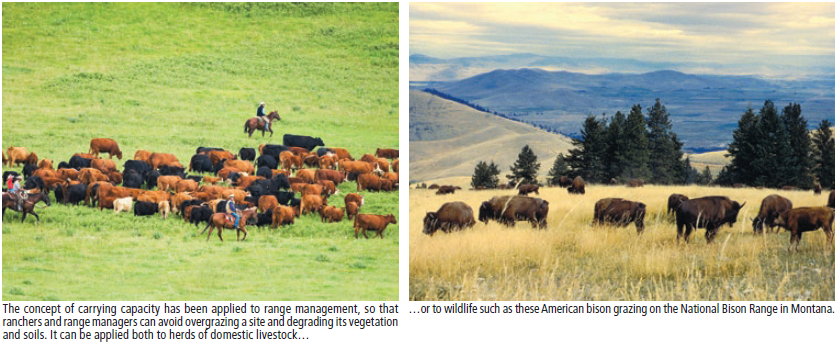
HABITAT OR ENVIRONMENT
Grasslands, tropical rainforests, coral reefs, wetlands, mudflats, marshes, temperate hardwood forests, estuaries, ponds and so forth are all relatively productive terrestrial or aquatic habitats in terms of their “standing biomass” and annual “net primary production” (i.e., the amount of plant matter produced annually by photosynthesis). Thus, they can support substantial populations of animals that feed on the plants and on each other in a cyclical food chain or food pyramid.
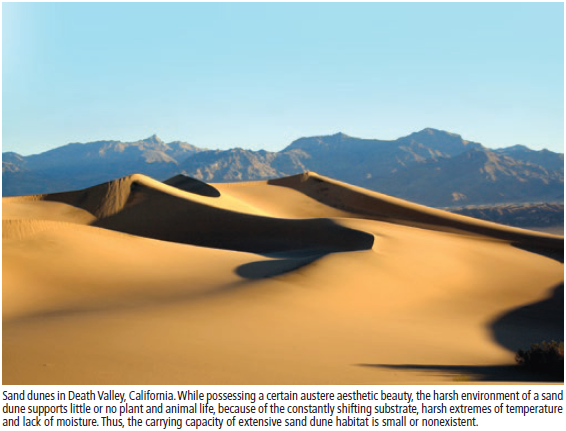 In contrast, deserts, Arctic tundra, alpine zones, Antarctica and the lunar surface all represent very low-quality, low-productivity habitats, and can support only very low population densities and low animal biomass.
In contrast, deserts, Arctic tundra, alpine zones, Antarctica and the lunar surface all represent very low-quality, low-productivity habitats, and can support only very low population densities and low animal biomass.
In the case of the moon, it can support no life at all, because it lacks an atmosphere and water and is subjected to brutal temperature extremes. Thus, we would say the moon has a carrying capacity for any species of zero. No terrestrial life could survive exposed to the lunar environment. When Americans visited the moon for brief periods in several NASA missions nearly half a century ago, their survival was made possible only because they were enveloped within small packets of Earth’s environment they carried with them at great expense in the form of air, water, warmth and food.
POPULATION OR MAXIMUM NUMBER, A.K.A. SUSTAINABILITY
In nature, wild populations rarely reach the full carrying capacity of a given habitat because of a variety of constraints, that is, ecological factors which keep their numbers in check. In the case of a bison herd grazing on prairie habitat in the Old West, for example, these factors would have included predation by wolves, cougars and Plains grizzly bears; disease; drought; brutally cold or snowy winters; competition for forage with other grazers and herbivores; and hunting by Plains Indians, first on foot and later on horseback.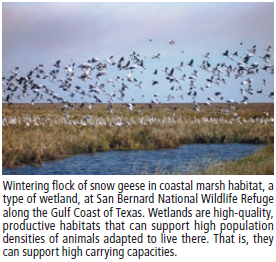
In most instances, times and places, a combination of these factors probably held bison populations at levels well below the theoretical carrying capacity of the range alone, that is, the number of bison that could be supported by the volume or biomass of the forage supplied annually by the grasses and forbs on the range.
All species in nature are held in check by forces such as those listed. In the case of apex predators (carnivores at the top of the food pyramid), these forces would include competition for food with others of their species. And the smaller the prey base, the more fierce the competition for a limited food supply. Those individual animals that are lower in the social dominance hierarchy (pecking order) get to eat less, and are thus less likely to survive or pass their genes onto the next generation. In Alaska, I have seen grizzly bears fighting over the best salmon fishing spots; their roars would punctuate the night in some of the remote field camps I lived and worked in as a fishery biologist.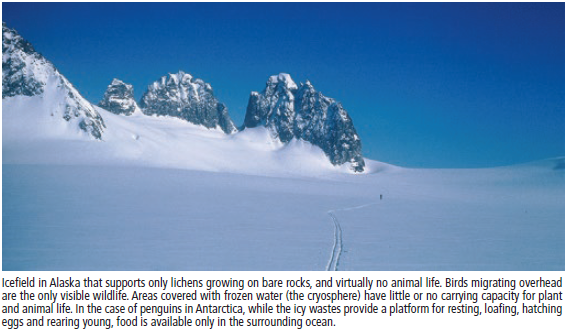
A number of species of birds, mammals and fish regulate population density – adjusting it to the amount of food and other resources available – by means of territoriality. They establish territories that they defend against interlopers. This limits access to critical resources, especially food. For example, a canoeist exploring the vast proliferation of lakes in the North Country, of, say, Minnesota and Ontario during the summer months will notice that lakes of a certain size have only one nesting pair of loons. No more than that. Loons are piscivorous, that is, they eat fish. That lone male and lone female and their offspring of that season are all that particular lake and its supply of fish can support. The bigger and or more productive a lake is, the more fish, loons, bald eagles and ospreys it can support.
IN PERPETUITY
Carrying capacity is not a fixed or hard ceiling above which it is impossible for populations to penetrate. With constraints removed, almost all populations have an innate tendency to increase exponentially. In exponential growth, the increment added to the growing quantity is proportional to the quantity already there; the bigger the existing quantity, the bigger the increase.
The treacherous power of exponential growth is staggering. If we start with a population of 1 of something, say, a mouse, after 10 population doublings there would be 512 mice, but after 20 doublings, there would be 524,288 mice. And after 30 doublings, there would be more than 530 million mice. As we can see, exponential growth results in faster and faster, or “runaway,” population growth, but only for a time, until other constraints bear down with a vengeance.
Once a population overshoots the long-term carrying capacity of its habitat it is only a question of time until it declines, or even collapses or crashes (i.e., declines precipitously), but usually not before damaging its habitat and reducing the ability of that 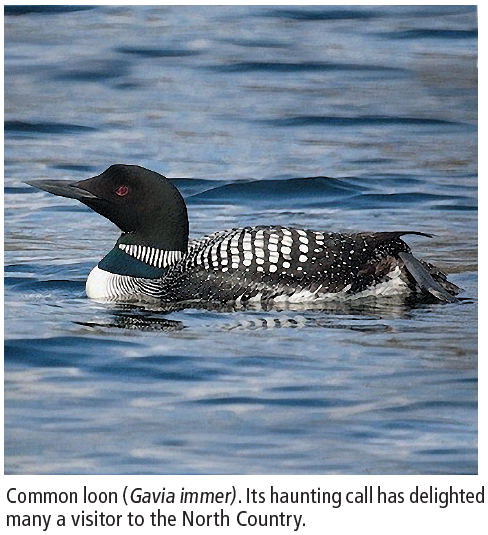 habitat to support future generations. If ever there were a theme song that encapsulates the ephemeral character of overshoot, it would be “Borrowed Time,” by the 1980s-era America rock band Styx, which contains the lyrics, “We’re livin’ high, livin’ fine, on borrowed time,” on their album Grand Illusion. Living high until the inevitable reckoning, that is.
habitat to support future generations. If ever there were a theme song that encapsulates the ephemeral character of overshoot, it would be “Borrowed Time,” by the 1980s-era America rock band Styx, which contains the lyrics, “We’re livin’ high, livin’ fine, on borrowed time,” on their album Grand Illusion. Living high until the inevitable reckoning, that is.
 When a population is growing exponentially, it is said to be undergoing a population “irruption.” (Note the similarity to the word “eruption.”) In nature, irruptions in the populations of microbes (like algae) or terrestrial herbivores like rodents can occur when conditions are unusually favorable, for example when food is abundant and weather ideal.
When a population is growing exponentially, it is said to be undergoing a population “irruption.” (Note the similarity to the word “eruption.”) In nature, irruptions in the populations of microbes (like algae) or terrestrial herbivores like rodents can occur when conditions are unusually favorable, for example when food is abundant and weather ideal.
Figure 1 shows such a population irruption, up to a peak, and followed by a crash. In this graph, K represents carrying capacity, N equals number or population size, and t equals time.
Note that the irruption is temporary or transitory. They are always transitory. Once N surpasses the K threshold (carrying capacity), its hours, days, weeks or years (depending on the species) are numbered, and a decrease will set in sooner or later.
Two famous 20th century examples of population irruptions of grazing animals in nature are deer on the Kaibab plateau in Arizona and reindeer on St. Matthew Island in Alaska. In the former, recounted by pioneering wildlife manager and conservationist Aldo Leopold, predators were removed to increase the number of deer for hunters, and the deer population exploded, damaged its habitat and died back.
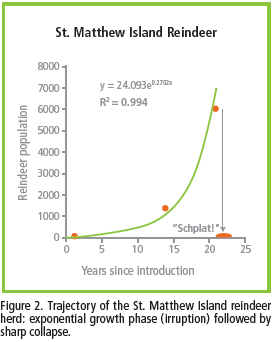 In the latter case, reindeer were transported by humans (the Coast Guard, in fact) to a remote island in Alaska’s Bering Sea on which they had never occurred naturally. Reindeer feed on lichens, and over the eons without any herbivores or ungulates to feed on them, St. Matthew Island had built up a thick carpet of lichens. Without any predators or hunters to keep their numbers in check, the reindeer herd was able to feed, and breed, with abandon, increasing exponentially from an initial population of 29 in 1944 to about 6,000 in 1963 (Figure 2).
In the latter case, reindeer were transported by humans (the Coast Guard, in fact) to a remote island in Alaska’s Bering Sea on which they had never occurred naturally. Reindeer feed on lichens, and over the eons without any herbivores or ungulates to feed on them, St. Matthew Island had built up a thick carpet of lichens. Without any predators or hunters to keep their numbers in check, the reindeer herd was able to feed, and breed, with abandon, increasing exponentially from an initial population of 29 in 1944 to about 6,000 in 1963 (Figure 2).
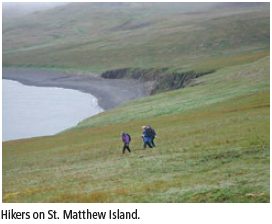 Then, after exhausting much of their food supply, the reindeer population was knocked down almost overnight to just 42 animals after an unusually severe winter in 1963-64 (Figure 2). By the 1980s, the population had died out entirely. Ecologists see this as a prime example of population irruption, overshoot and collapse or die-off. And we think that it represents a cautionary tale for humans, one that is ignored by society at large because it is awkward or even offensive, reeking as it does of “Malthusianism.”
Then, after exhausting much of their food supply, the reindeer population was knocked down almost overnight to just 42 animals after an unusually severe winter in 1963-64 (Figure 2). By the 1980s, the population had died out entirely. Ecologists see this as a prime example of population irruption, overshoot and collapse or die-off. And we think that it represents a cautionary tale for humans, one that is ignored by society at large because it is awkward or even offensive, reeking as it does of “Malthusianism.”
The human population is still in the midst of the most consequential population irruption of any vertebrate in the more than 500 million years vertebrates have existed on Earth (Figure 3). This population explosion cannot last much longer, but how it will end is still a matter of uncertainty…and great controversy. Will it end humanely because humanity’s aggregate birth rate will be lowered? Or will it end cruelly because the death rate will rise abruptly, as it did for the reindeer on St. Matthew Island?
Have human beings already overshot the carrying capacity of Planet Earth for human life, and if so, are we too headed for a crash?

 CARRYING CAPACITY, THE HUMAN CONDITION AND OUR COLLECTIVE PREDICAMENT
CARRYING CAPACITY, THE HUMAN CONDITION AND OUR COLLECTIVE PREDICAMENT
Many people are offended at the very idea that carrying capacity also applies to human beings. The late physicist Albert Bartlett, professor at the University of Colorado, author and presenter of the program “Arithmetic, Population and Energy: Sustainability 101,” used to refer to an example of multiplying bacteria to illustrate exponential population growth. For this, he was castigated for insinuating that humans are no smarter or better than bacteria. And many of those technophiles who worship technology as a secular god believe that human ingenuity and innovation will always outwit any limits imposed by nature.
But religious faith in man’s omniscience and omnipotence amounts to little more than a perilous union of hubris and hope. The belief that we can always hit the ball out of the park, when push comes to shove, is belied by the reality that it is nature which bats last.
Yet Homo sapiens is a very different creature than either reindeer or bacteria. We are indeed an anomaly, much, much smarter – possessed of cleverness, one might say, if lacking wisdom – and we are endowed with culture, communication and inventiveness that far exceed our nearest rivals and relatives in the animal kingdom.
Time and time again, we humans have invented things that allowed us to more effectively exploit our environment – tools, they are often called – permitting our range and our numbers to expand exponentially until we enveloped almost the entire Earth. Fire, clothing, spears, agriculture, wheels, wagons, animal husbandry, boats, writing, pumps, fertilizers, electricity and so on, by the thousands.
Arguably, these inventions, tools and weapons effectively expanded the human carrying capacity of the Earth, albeit at a terrible cost to other species and biodiversity generally (Figure 4), as we proliferated into every corner of the planet, save Antarctica.
The graph in Figure 4, prepared by blogger Paul Chefurka and based on the research of University of Manitoba ecologist Vaclav Smil, shows just how thoroughly humans have co-opted the terrestrial portion of the biosphere. Fully 95 percent or more of terrestrial vertebrate biomass consists of a handful of favored species: humans and our domesticated animals. Wildlife abundance and diversity have been decimated by our successes and excesses.
“Necessity is the mother of invention,” according to the old saw. Yet if dire necessity always spawned technical advances, all of the dozens of civilizations that have collapsed and disappeared into the dustbin
of human history would still be with us.
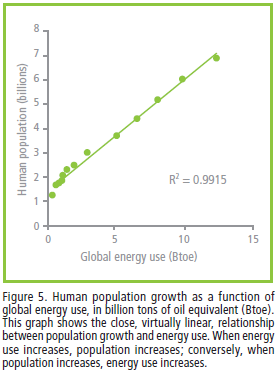 Does our capacity for endless invention to exploit ever more resources really exempt us from carrying capacity constraints – permanently expanding carrying capacity that is – or does it merely defer the inevitable ecological reckoning that may constitute our comeuppance? When we learned how to mine and pump fossil fuels en masse, which now supply 85 percent of the world’s primary energy, and which now represent the life-blood, as it were, of industrial civilization, were we really expanding carrying capacity, or had we merely been lured into a seductive trap – feasting on a one-time resource bonanza in a gluttonous orgy of consumption without parallel in the history of Life on Earth?
Does our capacity for endless invention to exploit ever more resources really exempt us from carrying capacity constraints – permanently expanding carrying capacity that is – or does it merely defer the inevitable ecological reckoning that may constitute our comeuppance? When we learned how to mine and pump fossil fuels en masse, which now supply 85 percent of the world’s primary energy, and which now represent the life-blood, as it were, of industrial civilization, were we really expanding carrying capacity, or had we merely been lured into a seductive trap – feasting on a one-time resource bonanza in a gluttonous orgy of consumption without parallel in the history of Life on Earth?
Those fossil fuels (coal, oil, natural gas) are closely linked with the human population irruption of the last two centuries (Figure 5), yet they are nonrenewable, finite and depletable; furthermore, their combustion is causing damaging and dangerous changes to our climate that are essentially irreversible within
human time scales.
How about a new water well and a diesel pump provided to impoverished populations in the dusty, sprawling Sahell (southern edge of the Sahara Desert in Africa) that can pump water from a deep fossil aquifer to irrigate crops and increase local food production, at least until the unreplenished fossil water runs out? Does that truly increase the local carrying capacity, or does it merely trigger a short-term population surge that is not sustainable? And when the water, and the food, run short, will the hapless people starve, or will they migrate to teeming, impoverished African shantytowns and then onto Europe and the U.S., as long as the gates remain open?
Wild species in nature depend for their survival on nature’s flows of energy. Solar energy striking the Earth’s surface is captured by chloroplast-containing green plants on the land and in the water. Via the miracle of photosynthesis, this energy is used to convert carbon dioxide and water into the simple sugar glucose, which is then used to manufacture all manner of more complex organic compounds. Plants and animals in the ecosystem are fundamentally constrained by these energy flow rates. And so were human societies, until the early 1800s, with the advent of the Fossil Fuel Era.
Using our smarts and technology, we learned how to exploit not only nature’s flows of energy, but its vast stocks of fuel, which had been created, stored and accumulated via geologic processes in the ancient past of the Carboniferous Period. Not for nothing have the fossil fuels been dubbed “ancient sunshine.” Yet while this ancient sunshine occurs in vast quantities, it is not inexhaustible.
In the meantime, the phenomenal explosion of human influence and impacts on the Earth triggered by our discovery and exploitation of the fossil fuels is extraordinary. It is similar to, but a million times more consequential than, the population explosion of reindeer on St. Matthew Island, uncontrolled by predators and feasting upon a rich endowment of lichens accumulated over the centuries and perhaps millennia.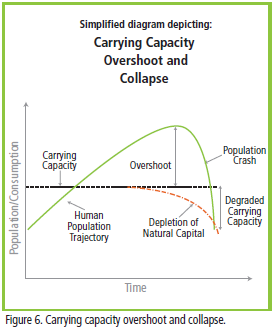
Figure 6 illustrates the phenomenon of carrying capacity overshoot and subsequent collapse. The red dashed curve,“Depletion of natural capital,” corresponds to the degradation of habitat discussed earlier. In the case of our industrial civilization, this refers to the depletion of resources, the filling up of sinks, and the degradation of ecosystem services. Depletion of natural resources includes exhaustion of both renewable and nonrenewable resources. Among the former are groundwater, surface water, arable soils, grasslands, forests, fisheries, wildlife and wetlands. Among the latter are coal, oil, natural gas, metals and minerals. “Sinks” refer to environmental media, primarily the atmosphere and water bodies, but also sheer space (room) and area.
Ecosystem services are benefits provided by ecosystem processes, and are broadly divided into four categories, including supporting services, provisioning services, regulating services and cultural services. Examples include nutrient recycling, primary production (manufacture of organic matter from photosynthesis), soil formation and conservation, food supply, flood regulation, water purification, freshwater storage and flow moderation, climate regulation, pollination and seed dispersal. These are critical to the survival and wellbeing of human societies.
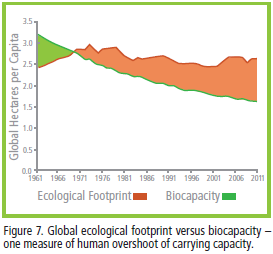 At present, on a global scale, human population is well advanced along the trajectory shown as the green curve in Figure 6. We have exceeded carrying capacity and entered the danger zone labeled “Overshoot.” We are depleting natural habitat and degrading the carrying capacity of the planet. This is the overriding message behind ecological footprint analysis as it has developed and evolved over the past two decades. The Oakland-based Global Footprint Network calculates that humanity’s worldwide ecological footprint surpassed the worldwide biocapacity (one measure of carrying capacity) in about 1970 (Figure 7).
At present, on a global scale, human population is well advanced along the trajectory shown as the green curve in Figure 6. We have exceeded carrying capacity and entered the danger zone labeled “Overshoot.” We are depleting natural habitat and degrading the carrying capacity of the planet. This is the overriding message behind ecological footprint analysis as it has developed and evolved over the past two decades. The Oakland-based Global Footprint Network calculates that humanity’s worldwide ecological footprint surpassed the worldwide biocapacity (one measure of carrying capacity) in about 1970 (Figure 7).
The ecological footprint is a measure of aggregate human demands, or the human load, imposed on the biosphere, or “ecosphere.” When all is said and done, the human economy, all production and all consumption of goods and services, depends entirely on the Earth’s natural capital – on arable soils, forests, croplands, pasturelands, fishing grounds, clean water and air, the atmosphere, ozone layer, climate, fossil fuels, minerals – to perform the ecological services and provide the materials and energy “sources” and waste “sinks” that sustain civilization.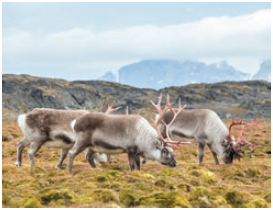
When the ecological footprint exceeds the biocapacity for the planet as a whole, or a given portion of it, such as a country like the United States, the planet or that country is in overshoot. It has overshot its carrying capacity, which is the precarious position the U.S. finds itself in (Figure 8). We are in the red, drawing down natural capital and exceeding carrying capacity, which is an unsustainable, untenable condition.
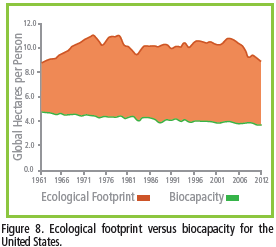 What can America and Americans do to lower our aggregate ecological footprint and get back in the black? Through a combination of public and private sector policy and individual action, we can reduce our resource consumption and waste output by conserving energy and using resources much more efficiently, and simply using less and living smarter overall.
What can America and Americans do to lower our aggregate ecological footprint and get back in the black? Through a combination of public and private sector policy and individual action, we can reduce our resource consumption and waste output by conserving energy and using resources much more efficiently, and simply using less and living smarter overall.
But another indispensable part of any approach to environmental sustainability and living within carrying capacity also must include halting U.S. population growth. We must stabilize our population – the number of “feet” causing our aggregate ecological footprint, as it were – and over time reduce both our population and ecological footprint to more sustainable levels.
These are tall orders, but doable ones. Hands down, they beat the alternative – irruption, overshoot and collapse. Just ask the reindeer on St. Matthew Island. Oh, wait, there aren’t any left to ask.
CAPS Senior Writing Fellow Leon Kolankiewicz is an environmental scientist and planner.




